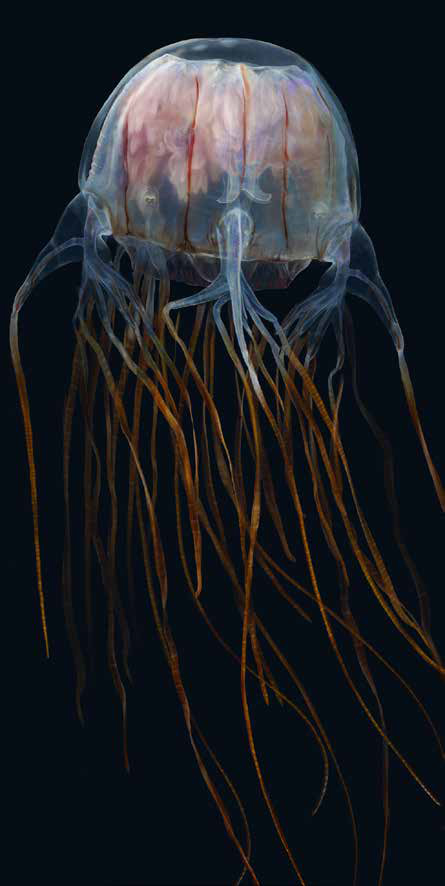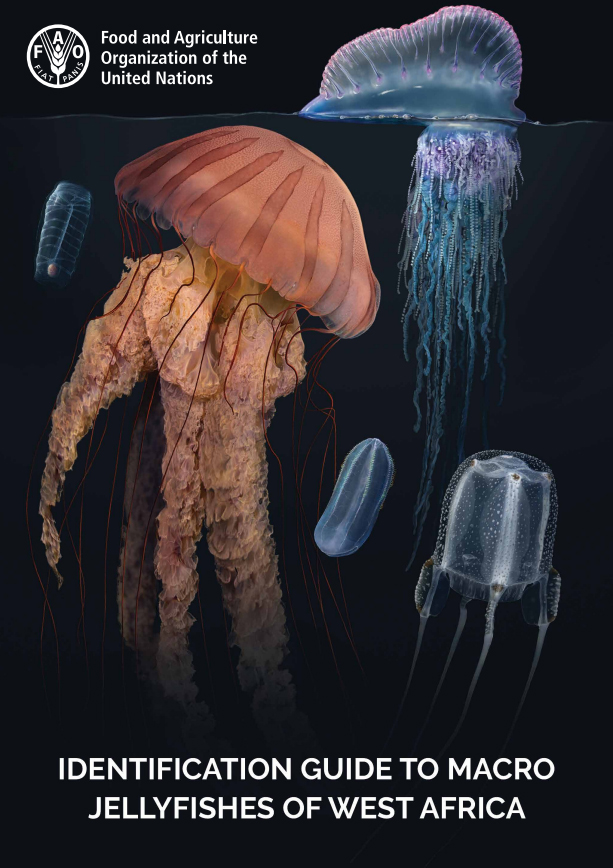Explore the wondrous jellyfish of West Africa in a new illustrated guide
The identification of jellyfish species can be difficult, and it is often challenging for even the more experienced researchers. Together with the University of the Western Cape (UWC), the EAF-Nansen Programme has taken on the challenge of updating and broadening the understanding of jellyfish around Africa through a variety of activities and products, including a new species identification guide of jellyfish found along the western seaboard of Africa.
The publication Identification Guide to Macro Jellyfishes of West Africa provides a fully illustrated glossary of 56 species of macro jellyfish, and it is not intended for specialists only. “For the first time, we have a user-friendly guide to the region’s jellyfish that can be used by fisheries scientists and observers, school teachers and professors alike” said the author of the publication, Professor Mark Gibbons from UWC.
 |
| The venom of box jellyfish like the Chirodropus gorilla from the family Chirodropidae is very potent and can cause severe reactions. © FAO/ Nicholas Bezio |
Growing jellyfish populations – a cause for concern or an unexplored resource?
With some exceptions, jellyfish are planktonic animals with a biomass comprising 96 percent water. They can be found in all marine ecosystems and can occur at very high densities. In some parts of the world, there is evidence to suggest that jellyfish populations are increasing, and this may be disruptive to both the environment and to the humans that use the environment. The direct negative effects of large numbers of jellyfish include clogged fishing nets and contaminated fish catches, but they may also replace important pelagic fish stocks.
Jellyfish are not only a cause for concern though as they play an important role in ocean ecosystems. They are both predators and prey and they could also represent an unexplored resource. All species of medusae (Cnidaria) contain variable amounts of collagen in their tissues, which can be harvested for pharmaceutical purposes and some species can be and are, eaten. Gibbons adds that “jellyfish fisheries exist around a number of Asian countries such as China, Thailand, India and Vietnam, as well as in the Gulf of California, Mexico. These mostly artisanal ventures support local communities for those parts of the year when jellyfish are abundant, and they provide a buffer when other resources are not available.”
Aside from its academic value and relevance to biodiversity, information on jellyfish around Africa is important for two reasons of worth to fishers and fisheries and environmental managers. It establishes the all-important baseline against which environmental and ecosystem change can be measured, and it provides an indication of new resources suitable for potential exploitation. Both of these aims require a tool that allows for the easy identification of jellyfish: they are not all equal.
Easy identification of a variety of macro jellyfish with illustrated keys
The focus of this species identification guide is on large jellyfish (= macro jellyfish), defined as animals with an adult size of > 5 cm in diameter/length. Large jellyfish tend to be more robust than smaller species with features that are easier to identify. The geographic area covers the Straits of Gibraltar in the north to the southern edge of the Agulhas Bank in the south. Other selected species deriving from the Mediterranean Sea, and from the southern Indian Ocean and Agulhas Current are also included as currents transfer these largely passive animals into the region.
In order to facilitate the identification process, the main groups of jellyfish can be identified using a pictorial key with ink drawings of the representative species from the groups. Once the main group has been determined, there are specific chapters with more detailed information and fully illustrated dichotomous keys that allow for the identification of the lower taxonomic levels.
Although this guide is intended to assist scientists in the identification of large jellyfish in situ, it may be necessary to collect specimens for more detailed study in the laboratory at a later date. Such endeavors could be aimed at confirming identification or enriching local collections, or they may be focused on aspects of individual biology. For this purpose, the guide contains protocols for sample fixation, preservation and image collection as well.
 |
In addition, jellyfish stings and treatments are explained. Among others, the effects of a sting from Box jellyfish (Chirodropida) is described. The venom of this group is very potent and can cause respiratory problems and cardiac arrest within few minutes, with death as a possible outcome. This is evidently one of the most daangerous species, but all jellyfish have venomous tools to catch prey. Although only some are dangerous to humans, it can be good to know how to avoid getting stung.
The guide is a contribution of the EAF-Nansen Programme to Theme 3 – Abundance and productivity of non-exploited resources – of its Science Plan, which is focused on understanding the biology, diversity, and ecological role of mesopelagic fish and jellyfish. It was developed by FAO in collaboration with UWC South Africa, the University of Sao Paulo, Brazil, the Medusa(‘)s Nursery Laboratory, Germany, and the University of Maryland, United States of America.
 |
To learn more, access and download the full guide here:
Identification guide to macro jellyfish of West Africa
Required citation: Gibbons, M.J., Morandini, A.C., Straehler-Pohl, I. & Bezio, N. 2022. Identification guide to macro jellyfishes of West Africa. FAO, Rome.
Other useful links:
- Putting jellyfish on the Nansen’s science agenda - Why the EAF-Nansen Programme decided to update and broaden the understanding of jellyfish around Africa
- The EAF-Nansen Programme Science Plan
